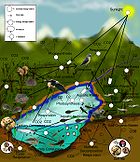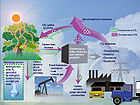- Bioaccumulation
-
Bioaccumulation refers to the accumulation of substances, such as pesticides, or other organic chemicals in an organism. [1] Bioaccumulation occurs when an organism absorbs a toxic substance at a rate greater than that at which the substance is lost. Thus, the longer the biological half-life of the substance the greater the risk of chronic poisoning, even if environmental levels of the toxin are not very high.[2]
Bioconcentration is a related but more specific term, referring to uptake and accumulation of a substance from water alone. By contrast, bioaccumulation refers to uptake from all sources combined (e.g. water, food, air, etc.)[3]
Contents
Examples
An example of poisoning in the workplace can be seen from the phrase "as mad as a hatter". The process for stiffening the felt used in making hats involved mercury, which forms organic species such as methylmercury, which is lipid soluble, and tends to accumulate in the brain resulting in mercury poisoning.
Other lipid (fat) soluble poisons include tetra-ethyl lead compounds (the lead in leaded petrol), and DDT. These compounds are stored in the body's fat, and when the fatty tissues are used for energy, the compounds are released and cause acute poisoning.
Strontium-90, part of the fallout from atomic bombs, is chemically similar enough to calcium that it is utilized in osteogenesis, where its radiation can cause damage for a long time.
Naturally produced toxins can also bioaccumulate. The marine algal blooms known as "red tides" can result in local filter feeding organisms such as mussels and oysters becoming toxic; coral fish can be responsible for the poisoning known as ciguatera when they accumulate a toxin called ciguatoxin from reef algae.
Some animal species exhibit bioaccumulation as a mode of defense; by consuming toxic plants or animal prey, a species may accumulate the toxin which then presents a deterrent to a potential predator. One example is the tobacco hornworm, which concentrates nicotine to a toxic level in its body as it consumes tobacco plants. Poisoning of small consumers can be passed along the food chain to affect the consumers later on. Other compounds that are not normally considered toxic can be accumulated to toxic levels in organisms. The classic example is of Vitamin A, which becomes concentrated in carnivore livers of e.g. polar bears: as a pure carnivore that feeds on other carnivores (seals), they accumulate extremely large amounts of Vitamin A in their livers. It was known by the native peoples of the Arctic that the livers should not be eaten, but Arctic explorers have suffered Hypervitaminosis A from eating the bear livers (and there has been at least one example of similar poisoning of Antarctic explorers eating husky dog livers). One notable example of this is the expedition of Sir Douglas Mawson, where his exploration companion died from eating the liver of one of their dogs.
Coastal fish (such as the smooth toadfish) and seabirds (such as the Atlantic Puffin) are often monitored for heavy metal bioaccumulation.
In some eutrophic aquatic systems, biodilution can occur. This trend is a decrease in a comtaminant with in increase in trophic level and is due to higher concentrations of algae and bacteria to "dilute" the concentration of the pollutant.
See also
- Bioconcentration factor
- Biomagnification (magnification of toxins with increasing trophic level)
- Chelation therapy
- International POPs Elimination Network
- List of environment topics
References
- ^ [1] USGS Toxic Substances Hydrology Program: Bioaccumulation
- ^ Bioaccumulation of Marine Pollutants [and Discussion], by G. W. Bryan, M. Waldichuk, R. J. Pentreath and Ann Darracott Philosophical Transactions of the Royal Society of London. Series B, Biological Sciences © 1979 The Royal Society.
- ^ http://toxics.usgs.gov/definitions/bioconcentration.html
External links
- http://www.marietta.edu/~biol/102/2bioma95.html
- http://www.mhhe.com/biosci/esp/2001_gbio/folder_structure/ec/m3/s4/ (excellent graphic)
- http://toxics.usgs.gov/definitions/biomagnification.html
- http://www.pbtprofiler.net/criteria.asp
Toxicology Fields Concepts Poison · Venom · Toxicant (Toxin) · Acceptable daily intake · Acute toxicity · Bioaccumulation · Biomagnification · Fixed Dose Procedure · Median lethal dose (LD50) · Lethal dose · Toxic capacity · Toxicity ClassTreatments Incidents Bradford · Minamata · Niigata · Alexander Litvinenko · Bhopal · 2007 pet food recalls · Seveso disaster · List of poisoningsRelated topics Categories:- Biodegradation
- Biodegradable waste management
- Pollution
- Toxicology
Wikimedia Foundation. 2010.


